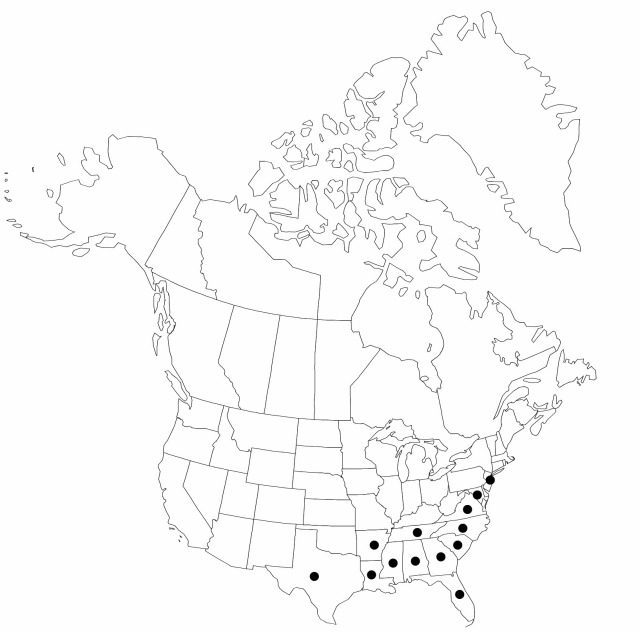Eleocharis tortilis
Mant. 2: 92. 1824.
Plants perennial, forming dense clumps, not stoloniferous, rhizomatous. Rhizomes usually present, caudexlike, ascending, 1 mm thick, hidden by crowded culms; internodes and scales not evident. Culms sometimes spirally twisted, usually minutely red-spotted at 30X, acutely triangular or sometimes elliptic, 15–70 cm × 0.3–0.5 (–1) mm, soft (to firm), often minutely granular at 10X. Leaves: distal leaf-sheaths persistent, stramineous to green, often minutely red-spotted, membranous to papery, apex subacute to narrowly acute, often with toothlike callus. Spikelets: basal spikelets absent; never proliferous, ovoid to lanceoloid or ellipsoid, terete, 4–12 × 2–4 mm, apex acute; proximal scale empty, deciduous, clasping 1/2 of culm, similar to floral scales; subproximal scale often empty; floral scales spiraled, 10–25, 5–6 per mm of rachilla, pale orangebrown, midrib regions broadly pale green to colorless, broadly ovate, 2–2.5 (–3.5) × 1.5–2 mm, central area and often flanks papery to cartilaginous or sometimes membranous, midrib evident, apex subacute (to rounded). Flowers: perianth bristles 4–6, bright brown, stout, equaling to slightly exceeding tubercle; spinules dense, retrorse, sharply acute; stamens 3; anthers 0.5–0.9 mm; styles 3-fid. Achenes medium brown or yellowish or greenish, obpyriform, obtusely (often obscurely) compressed trigonous, angles evident, 1.2–1.7 (–2.4) × 0.9–1.2 (–2.2) mm, apex constricted proximal to tubercle, coarsely cancellate at 10X, each face with 8–10 longitudinal rows of distinctly depressed, enlarged cells. Tubercles brown to greenish (or bone-white), pyramidal, trigonous or cross-section planoconvex, 0.3–0.7 (–1) × 0.3–0.6 (–0.9) mm, distinctly shorter or narrower than achene, apex acute, often acuminate.
Phenology: Fruiting spring (in south)–fall.
Habitat: Wet soil, freshwater, acidic places, seeps, bogs, ditches
Elevation: 10–100 m
Distribution

Ala., Ark., Fla., Ga., La., Md., Miss., N.J., N.C., S.C., Tenn., Tex., Va.
Discussion
Eleocharis tortilis differs consistently from E. tuberculosa only in tubercle size. Most specimens of E. tortilis have culms that are sharply trigonous and no more than 0.5 mm wide. However, about two-thirds of the specimens of E. tortilis from Texas resemble E. tuberculosa in having culms that are elliptic or subelliptic in cross section and that sometimes reach 1 mm wide. Those elliptic-culmed plants may deserve taxonomic recognition. I have not seen voucher specimens for reports in the literature (H. K. Svenson 1937; M. L. Brown and R. G. Brown 1984) for Alabama (Mobile, 1800s), Delaware (1908), Maryland (1863–1878), and New York (Long Island, 1903).
Selected References
None.
Lower Taxa
"shortened" is not a number."distinctly shorter or narrower" is not a number.
